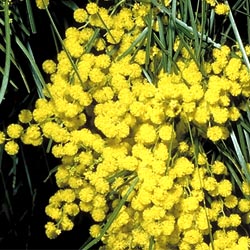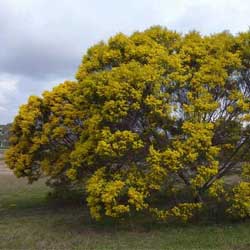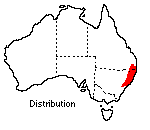Acacia adunca
 |
 |
Wallangarra Wattle
Acacia adunca A.Cunn. ex G.Don
Acacia adunca is found on the tablelands of southern Queensland and northern New South Wales. This region has predominantly granite soils and a high annual rainfall; winter frosts are common. The common name of Wallangarra Wattle refers to the town on the border of New South Wales and Queensland.
 Acacia
adunca can be either a small tree, 6m high by 3 m across, or a large, spreading
shrub, the latter being promoted under cultivation by regular pruning immediately
following flowering. This may also serve to lengthen the plant's life span and
increase flowering in subsequent years.
Acacia
adunca can be either a small tree, 6m high by 3 m across, or a large, spreading
shrub, the latter being promoted under cultivation by regular pruning immediately
following flowering. This may also serve to lengthen the plant's life span and
increase flowering in subsequent years.
The 'leaves' (in fact phyllodes) are dark green and lustrous and in warm weather may feel oily to touch. They are pendulous, and 60 - 100mm long
The flowers are bright yellow spheres borne in simple racemes about 30 mm long. They arise near and at the ends of branchlets, and their weight causes the outer branches to become pendulous during flowering. Flowering is prolonged and prolific, extending from the end of July through winter to early October, a time of year when colour in the garden is most welcome in Canberra. An added bonus is the pleasantly sweet fragrance of the flower.
Seed can be harvested during the summer and sown in individual containers the following spring. Before sowing, however, the seed should be treated to break down the hard coat. Boiling water may be poured over the seed and left to soak for several hours. An alternative form of treatment is to scarify the seed. Go to this page for hints on propagation.
Under cultivation, a position in full sun with ample water and good drainage will suit the plant best. There is an indication in the Australian National Botanic Gardens that, given the plant's native habitat, it will tolerate considerably less water than is supplied in the Gardens. While the plants are young, however, ample water and applications of nitrogenous-based fertilisers will ensure quicker establishment and maintain vigour.
This acacia appears to be less prone to borer attack and scale insects than other members of the genus. It has strong timber, is not easily damaged in high winds, and is an Acacia which should be more widely cultivated.
(Look here for a glossary of botanical terms)
Text by R J Nipperess(1979)
Name meaning: Acacia aduncaAcacia - may be from a Greek word meaning to sharpen, referring to the prickly nature of the first species discovered; another opinion refers to the Egyptian thorn (akakia), a species of Acacia which yields gum arabic; adunca - from the Latin word aduncus, meaning hooked or crooked, a reference to the phyllode apex. |
![An Australian Government Initiative [logo]](/images/austgovt_brown_90px.gif)

